THE YI MINORITY: THE HIDDEN FOOTPRINTS OF CHINA
 By Michelle BulterysStaff WriterThe Yi ethnic minority of almost 8 million people spans out across Sichuan, Yunnan, and Guizhou in southwest China. Its complex and rich culture has been kept a secret for generations. For years, the Chinese government noted the Yi to have just two languages; but a closer look showed that those two languages further distinguished into eighteen exclusively intelligible languages. The Yi’s footprints may have been hidden, but they haven’t been erased. Such a rich culture should be celebrated, and what better way than through photographs?Not only is Yi’s culture unique, but so is its HIV/AIDS footprint. Globally, the most common mode of HIV/AIDS transmission is still through sexual intercourse. However, among the Yi Minority nearly 80 percent of new HIV/AIDS infections are the result of drug injections, which is high when compared to the global average of only 10 percent.My time spent in Zhaojue has shown me that HIV/AIDS is much more than a medical problem—it is a social problem. One of the many challenges of global health is implementing education, diagnosis, and treatment appropriately into the specific culture at hand.
By Michelle BulterysStaff WriterThe Yi ethnic minority of almost 8 million people spans out across Sichuan, Yunnan, and Guizhou in southwest China. Its complex and rich culture has been kept a secret for generations. For years, the Chinese government noted the Yi to have just two languages; but a closer look showed that those two languages further distinguished into eighteen exclusively intelligible languages. The Yi’s footprints may have been hidden, but they haven’t been erased. Such a rich culture should be celebrated, and what better way than through photographs?Not only is Yi’s culture unique, but so is its HIV/AIDS footprint. Globally, the most common mode of HIV/AIDS transmission is still through sexual intercourse. However, among the Yi Minority nearly 80 percent of new HIV/AIDS infections are the result of drug injections, which is high when compared to the global average of only 10 percent.My time spent in Zhaojue has shown me that HIV/AIDS is much more than a medical problem—it is a social problem. One of the many challenges of global health is implementing education, diagnosis, and treatment appropriately into the specific culture at hand.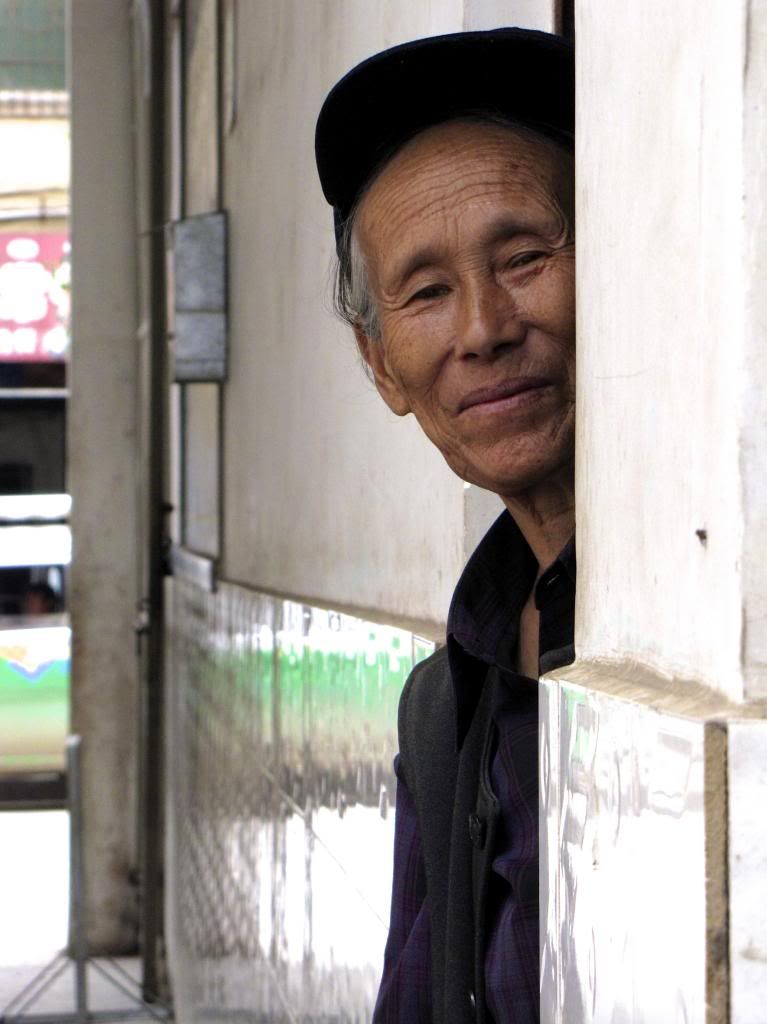 Her eyes had seen so much, maybe too much, for one lifetime. Xing tells me of the many children that she had lost to HIV/AIDS due to injecting drug use. The moment the methadone clinic opened in Zhaojue, Xing moved in downstairs as a cleaner to be in the presence of people trying to cure themselves of heroin addictions. When I asked to take a picture of her, she ran into her one-bedroom home and said to take pictures of the children because she wasn’t pretty enough for the camera. But in her foreseeable curiosity, she poked her head out and asked for one photograph.
Her eyes had seen so much, maybe too much, for one lifetime. Xing tells me of the many children that she had lost to HIV/AIDS due to injecting drug use. The moment the methadone clinic opened in Zhaojue, Xing moved in downstairs as a cleaner to be in the presence of people trying to cure themselves of heroin addictions. When I asked to take a picture of her, she ran into her one-bedroom home and said to take pictures of the children because she wasn’t pretty enough for the camera. But in her foreseeable curiosity, she poked her head out and asked for one photograph. The challenge of HIV/AIDS has shifted. Before it was the challenge of developing a treatment, but now it is the challenge of distributing and properly implementing treatment to those in need. Inaccurate use of Anti-retro Viral Treatment (ART) causes resistance to the effects of the medicine. The doctors of the clinic proudly informed us of an increase in mothers arriving for prenatal testing from one in 2012 to 60 in 2013. This curious boy looked out the window as his mother received her HIV/AIDS treatment. She was one of the many mothers to receive treatment early in her pregnancy, which ultimately saved her son.
The challenge of HIV/AIDS has shifted. Before it was the challenge of developing a treatment, but now it is the challenge of distributing and properly implementing treatment to those in need. Inaccurate use of Anti-retro Viral Treatment (ART) causes resistance to the effects of the medicine. The doctors of the clinic proudly informed us of an increase in mothers arriving for prenatal testing from one in 2012 to 60 in 2013. This curious boy looked out the window as his mother received her HIV/AIDS treatment. She was one of the many mothers to receive treatment early in her pregnancy, which ultimately saved her son.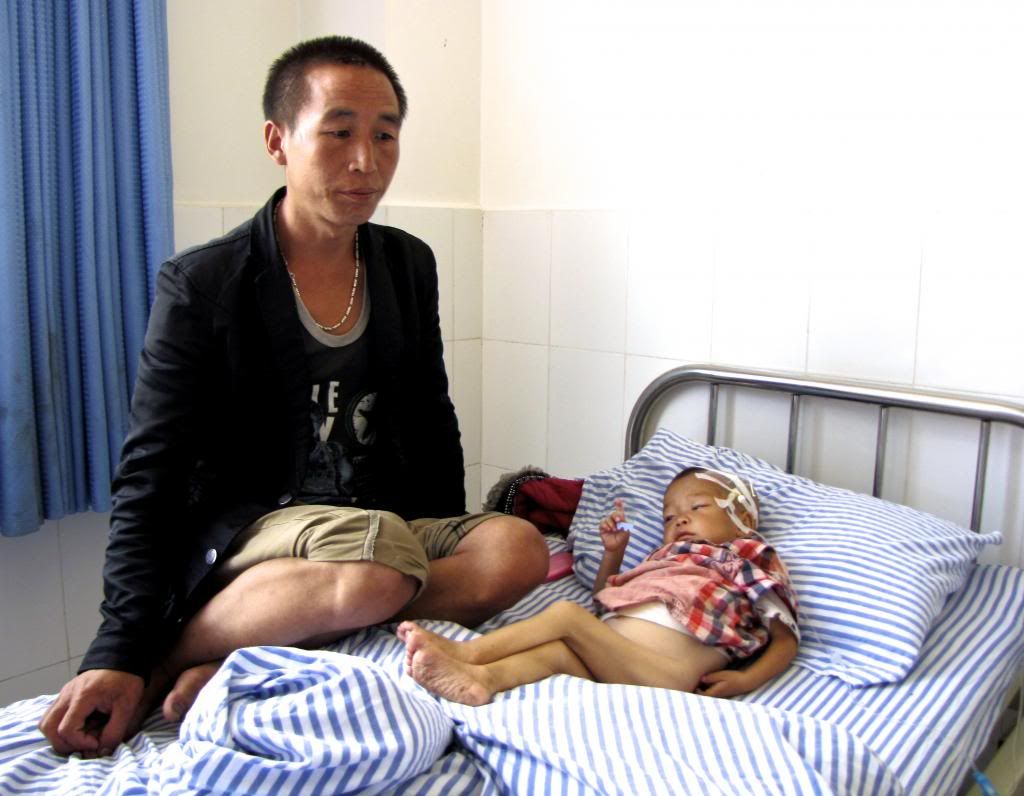 In the Mother and Child Hospital, a father waited anxiously beside his 3-year-old daughter for the doctor to return with her records. The mother of the child recently passed away from HIV/AIDS, and the child has been infected with the disease since birth. To this day, the Yi remain traditional in their birthing practices, as 30 percent of births are still performed at home. By increasing the number of hospital births, more mothers can be tested and receive treatment earlier in their pregnancies when it is most critical. After checking the child’s vitals and speaking privately with the father for an hour, the doctor comes outside to tell us the girl would not survive the month.
In the Mother and Child Hospital, a father waited anxiously beside his 3-year-old daughter for the doctor to return with her records. The mother of the child recently passed away from HIV/AIDS, and the child has been infected with the disease since birth. To this day, the Yi remain traditional in their birthing practices, as 30 percent of births are still performed at home. By increasing the number of hospital births, more mothers can be tested and receive treatment earlier in their pregnancies when it is most critical. After checking the child’s vitals and speaking privately with the father for an hour, the doctor comes outside to tell us the girl would not survive the month.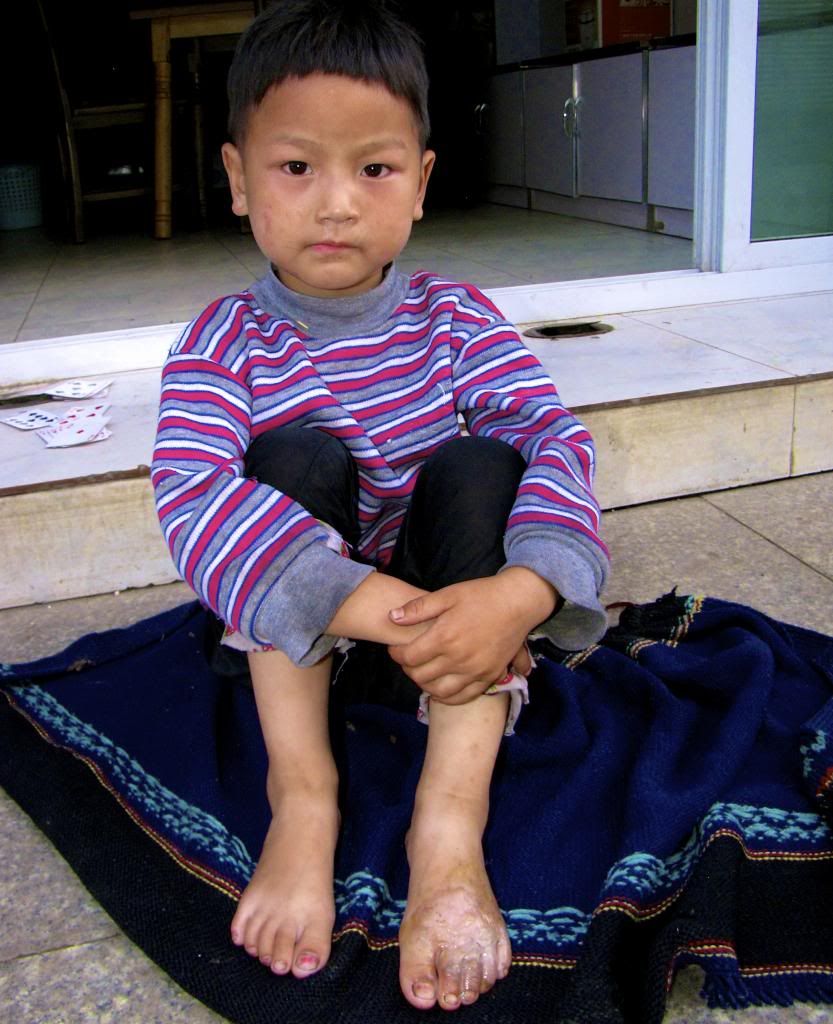 At age 6, this young girl is often left alone to be in charge of her family’s small restaurant. Her maturity and intellect are those of an adolescent, while her petite size and undeveloped strength challenge her in the kitchen. A week before this photo was taken, a boiling pot of oil had fallen on her foot. She sits outside of the restaurant, alone, with sleeves damp from tears.
At age 6, this young girl is often left alone to be in charge of her family’s small restaurant. Her maturity and intellect are those of an adolescent, while her petite size and undeveloped strength challenge her in the kitchen. A week before this photo was taken, a boiling pot of oil had fallen on her foot. She sits outside of the restaurant, alone, with sleeves damp from tears.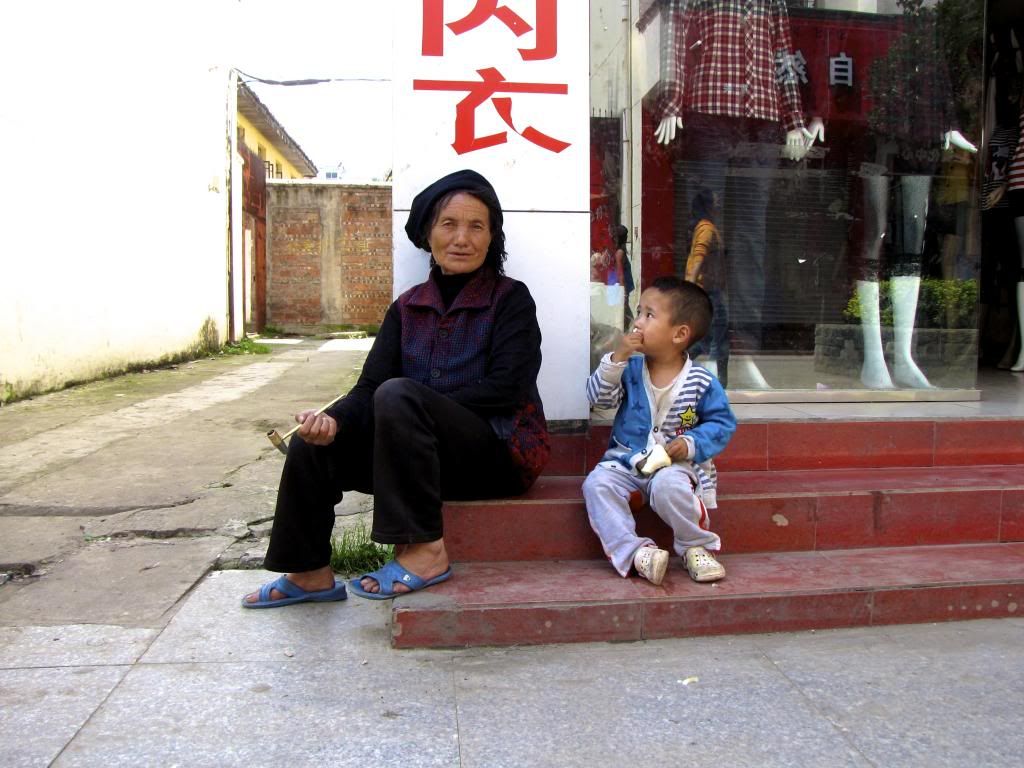 The young and old of the Yi minority are often the only people on the streets of Zhaojue. This picture represents the youth looking up to the elders for guidance and wisdom, a characteristic that has kept the Yi culture alive through the generations.
The young and old of the Yi minority are often the only people on the streets of Zhaojue. This picture represents the youth looking up to the elders for guidance and wisdom, a characteristic that has kept the Yi culture alive through the generations. This gentleman was the owner of the fruit stand across the street. He was notorious throughout town for being undefeated in Chinese checkers.
This gentleman was the owner of the fruit stand across the street. He was notorious throughout town for being undefeated in Chinese checkers.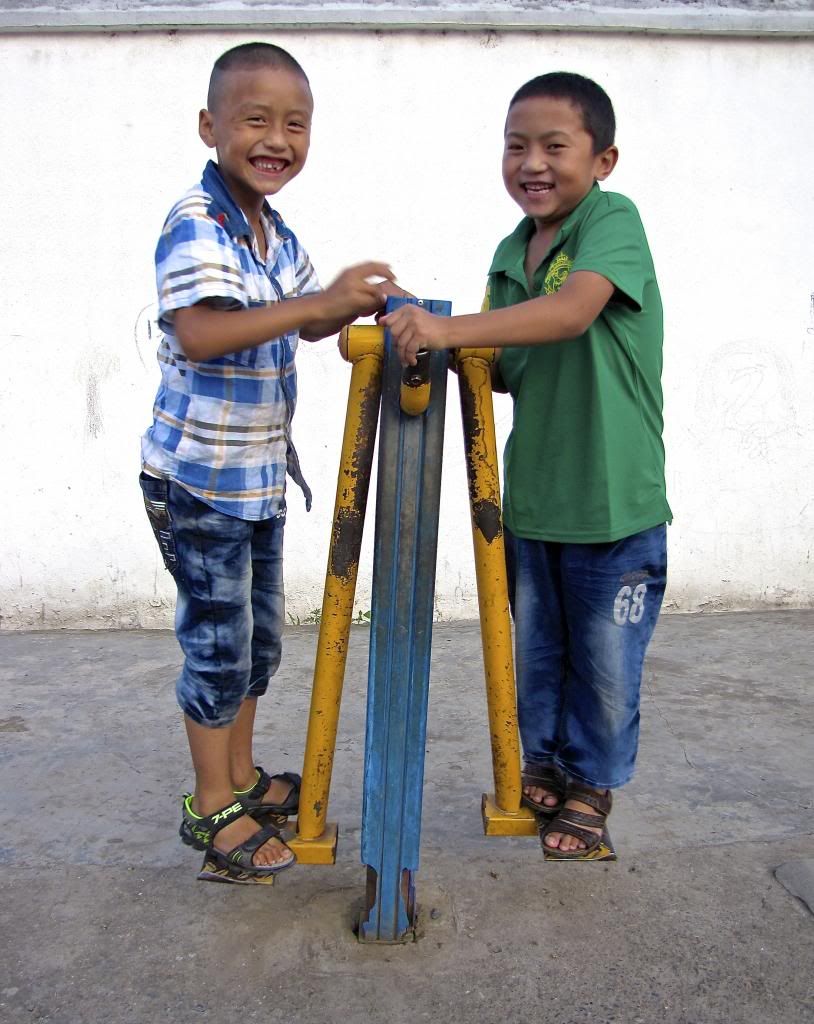 Two young boys play on exercise machines in the local courtyard.
Two young boys play on exercise machines in the local courtyard.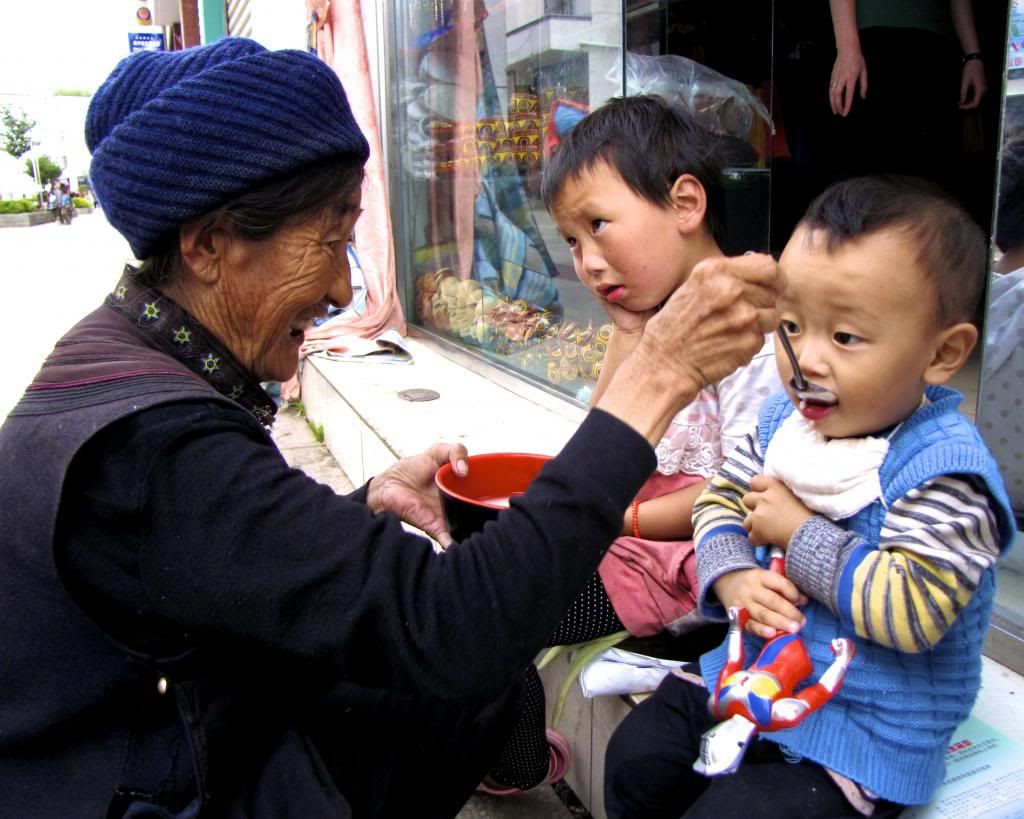 Like in many Chinese communities, the grandparents are the sole caretakers of the children. Rice porridge was served as little entertainment for this boy, and he quickly swallowed two hefty bites to his grandmother’s delight before running off with his action figures. His sister’s impatience continued to display in her eyes until her hunger was finally satisfied with the remaining porridge.
Like in many Chinese communities, the grandparents are the sole caretakers of the children. Rice porridge was served as little entertainment for this boy, and he quickly swallowed two hefty bites to his grandmother’s delight before running off with his action figures. His sister’s impatience continued to display in her eyes until her hunger was finally satisfied with the remaining porridge. This picture was taken in one of the many traditional Yi clothing stores in Zhaojue. This boy and his sister struggled to hold in their laughter in the presence of a foreign girl dressed in traditional clothing.
This picture was taken in one of the many traditional Yi clothing stores in Zhaojue. This boy and his sister struggled to hold in their laughter in the presence of a foreign girl dressed in traditional clothing.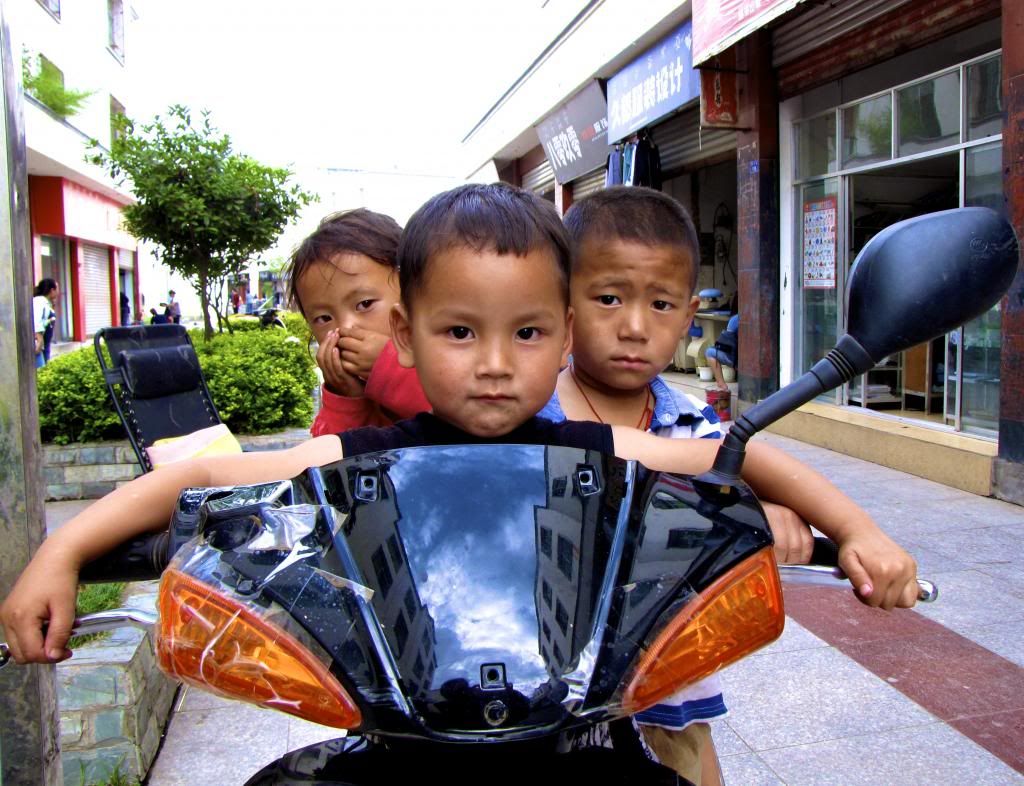 Many of the Yi minority disregard Chinese regulations, in particular the “One-Child” policy. I met these three siblings while in line at the grilled potato stand. After staring at me and whispering amongst each other, they asked me if I had ever seen a certain movie. When I admitted that I hadn’t seen the movie, they ran to the closest moped, climbed upon it in unison, and posed for a picture. I later found out that the movie was the Chinese version of Die Hard.
Many of the Yi minority disregard Chinese regulations, in particular the “One-Child” policy. I met these three siblings while in line at the grilled potato stand. After staring at me and whispering amongst each other, they asked me if I had ever seen a certain movie. When I admitted that I hadn’t seen the movie, they ran to the closest moped, climbed upon it in unison, and posed for a picture. I later found out that the movie was the Chinese version of Die Hard.
